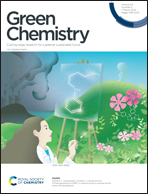A salt-free pickling and chrome-free tanning technology: a sustainable approach for cleaner leather manufacturing†
Abstract
Tannery effluents contain harmful pollutants, such as chromium, total dissolved solids, and neutral salts (chlorides), and hence researchers have focused on eco-benign pickling and tanning processes. Here, a sustainable approach employs a salt-free pickling and chrome-free tanning process for cleaner leather manufacturing. Pretreatment with 8% epoxy-terminated hyperbranched poly(amine-ester) (abbreviated as EHBP) before pickling controlled the swelling of the skin in the pickling process, in the absence of conventional neutral salts. Subsequent tanning preferably with a 6% aluminum tanning agent (abbreviated as AL) improved the hydrothermal stability of the resultant crust. It also promoted the subsequent dyeing or fatliquoring in a wet finishing process, as well as ameliorated the yellowing resistance and chemical stability of the tanned leather. This study showed that without compromising on the quality of finished leather, EHBP could ensure a salt-free pickling and chrome-free tanning process and prevent the pollution of tannery effluents (Cl− and Cr3+) with a promising development for large-scale green production.



 Please wait while we load your content...
Please wait while we load your content...